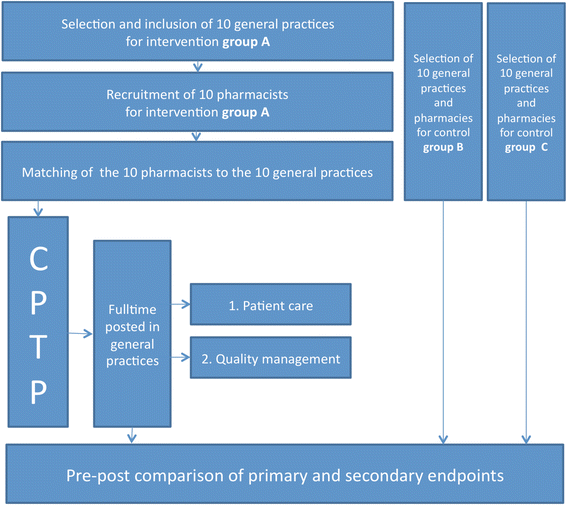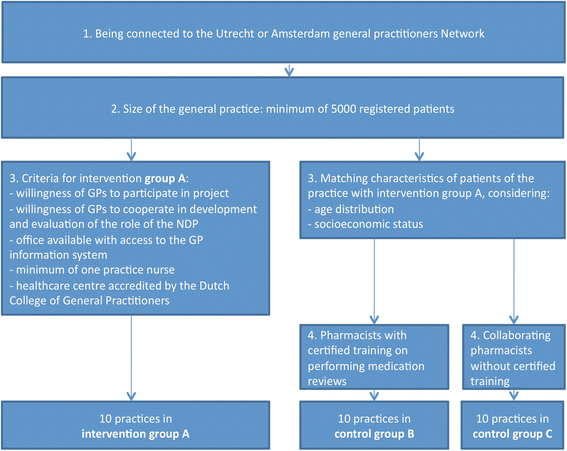Design of the POINT study: Pharmacotherapy Optimisation through Integration of a Non-dispensing pharmacist in a primary care Team (POINT)
- PMID: 26135582
- PMCID: PMC4489035
- DOI: 10.1186/s12875-015-0296-8
Design of the POINT study: Pharmacotherapy Optimisation through Integration of a Non-dispensing pharmacist in a primary care Team (POINT)
Abstract
Background: In the Netherlands, 5.6 % of acute hospital admissions are medication-related. Almost half of these admissions are potentially preventable. Reviewing medication in patients at risk in primary care might prevent these hospital admissions. At present, implementation of medication reviews in primary care is suboptimal: pharmacists lack access to patient information, pharmacists are short of clinical knowledge and skills, and working processes of pharmacists (focus on dispensing) and general practitioners (focus on clinical practice) match poorly. Integration of the pharmacist in the primary health care team might improve pharmaceutical care outcomes. The aim of this study is to evaluate the effect of integration of a non-dispensing pharmacist in general practice on the safety of pharmacotherapy in the Netherlands.
Methods: The POINT study is a non-randomised controlled intervention study with pre-post comparison in an integrated primary care setting. We compare three different models of pharmaceutical care provision in primary care: 1) a non-dispensing pharmacist as an integral member of a primary care team, 2) a pharmacist in a community pharmacy with a predefined training in performing medication reviews and 3) a pharmacist in a community pharmacy (care as usual). In all models, GPs remain accountable for individual medication prescription. In the first model, ten non-dispensing clinical pharmacists are posted in ten primary care practices (including 5 - 10 000 patients each) for a period of 15 months. These non-dispensing pharmacists perform patient consultations, including medication reviews, and share responsibility for the pharmaceutical care provided in the practice. The two other groups consist of ten primary care practices with collaborating pharmacists. The main outcome measurement is the number of medication-related hospital admissions during follow-up. Secondary outcome measurements are potential medication errors, drug burden index and costs. Parallel to this study, a qualitative study is conducted to evaluate the feasibility of introducing a NDP in general practice.
Discussion: As the POINT study is a large-scale intervention study, it should provide evidence as to whether integration of a non-dispensing clinical pharmacist in primary care will result in safer pharmacotherapy. The qualitative study also generates knowledge on the optimal implementation of this model in primary care. Results are expected in 2016.
Trial registration number: NTR4389 , The Netherlands National Trial Register, 07-01-2014.
Figures
References
-
- Leendertse AJ, Egberts ACG, Stoker LJ, van den Bemt PMLA. Frequency of and risk factors for preventable medication-related hospital admissions in the Netherlands. Arch Intern Med. 2008;168:1890–6. - PubMed
Publication types
MeSH terms
Associated data
LinkOut - more resources
Full Text Sources
Other Literature Sources
Medical
Research Materials



